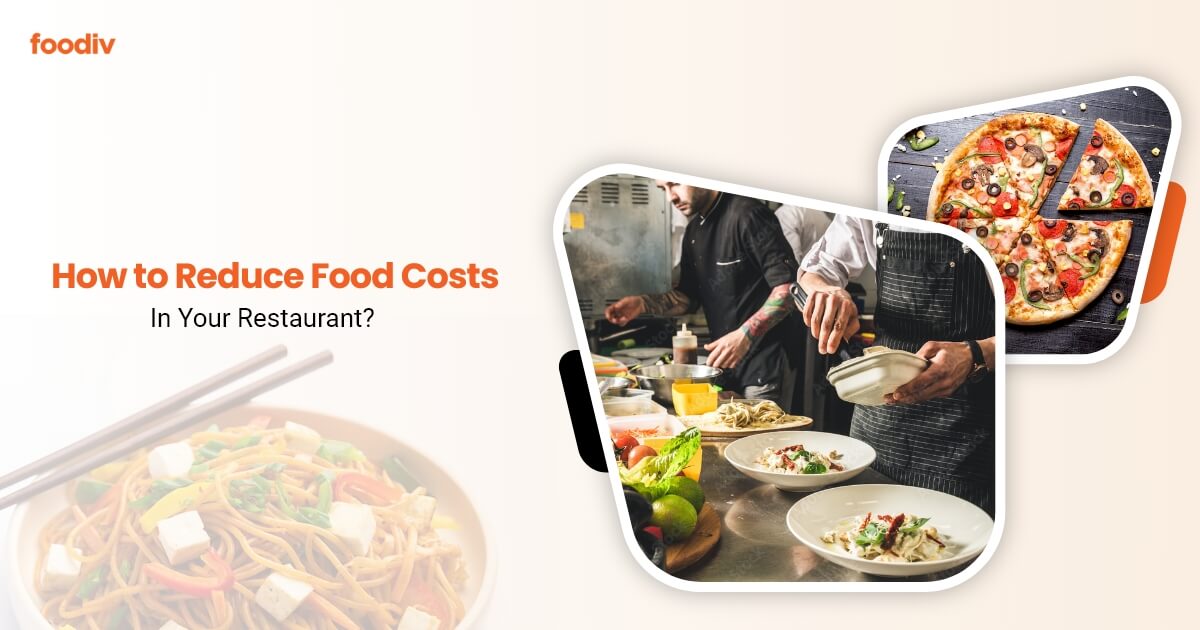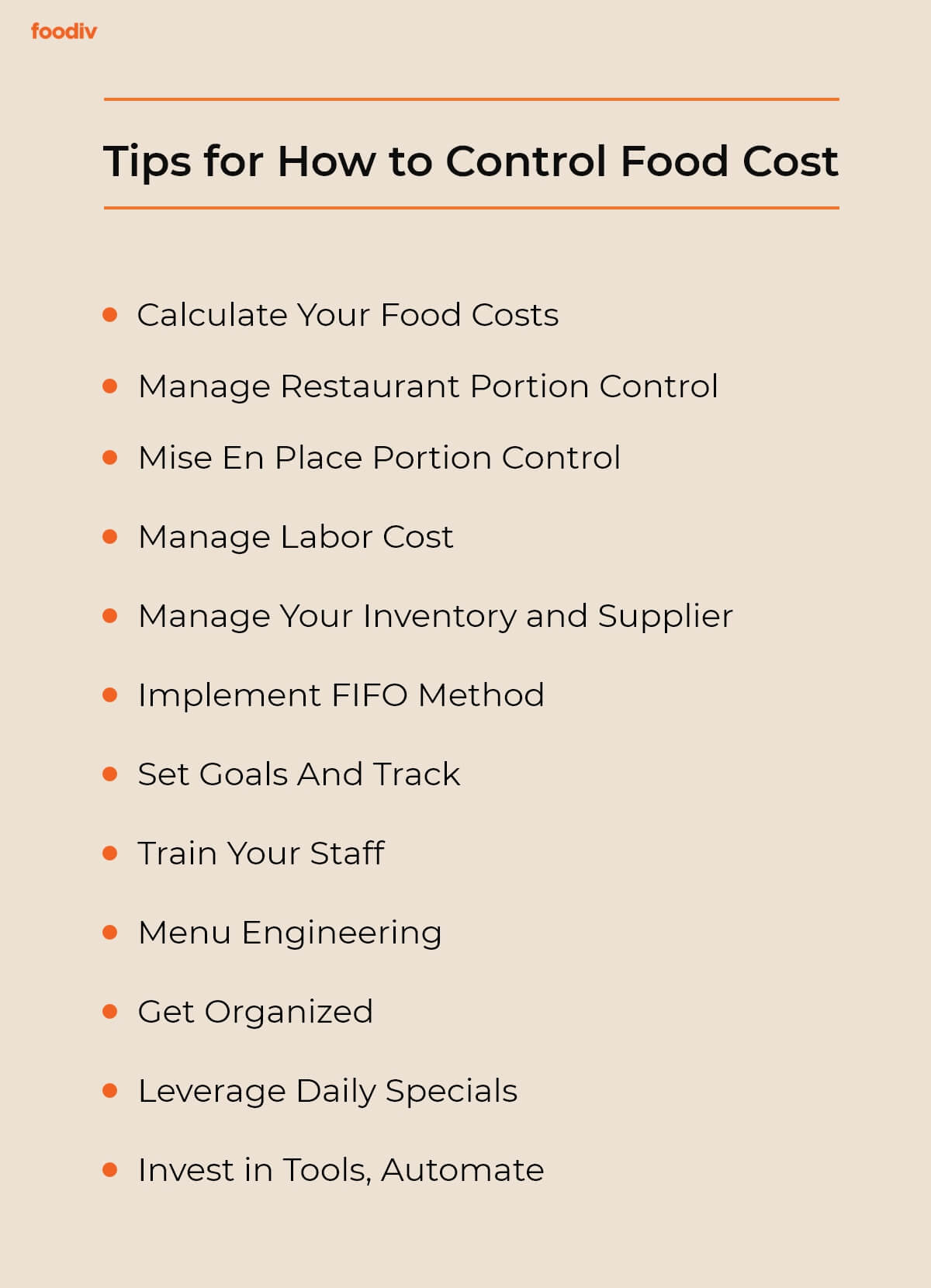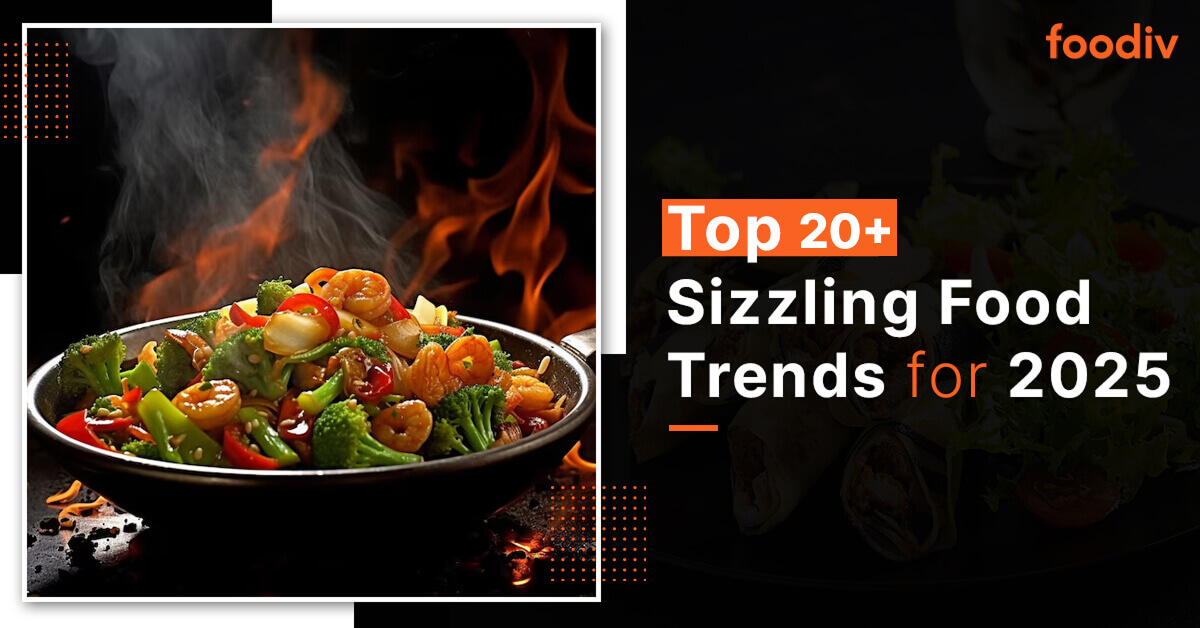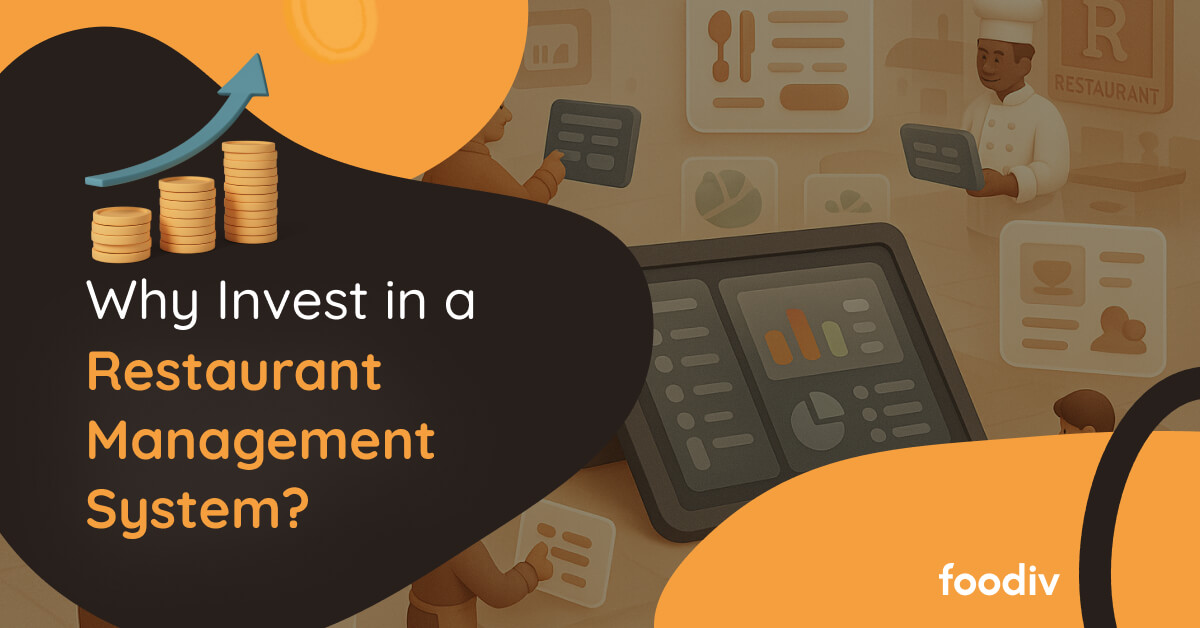
Quick Summary: Excessive restaurant food cost can hurt your bottom line, especially if you are a small or medium-sized restaurant owner. You need to implement certain measures to curb the loopholes, and that’s how you can control food costs. Having control over restaurant food costs is a challenge for many and hence we have brought a comprehensive guide for how to control food costs and increase profit margins. Let’s explore;
Are you starting a new restaurant business? Do you want to explore what keeps you restaurant business profitable? Are you working to increase profit margins for your restaurant? Have you explored ideas to control food costs, but all your effort went in vain?
Let’s face it: In the fiercely competitive restaurant industry, the basic formula for average food purchases by sales is no longer sufficient. You need to find proven methods of controlling food costs. Indeed, you can open a restaurant by going through a few articles online, though keeping your restaurant profitable, you need to have a strategy.
To reduce cost in the restaurant business and the goods sold to calculate food costs, you must have the necessary knowledge.
So keeping those points in mind, We have in this article brought detailed information that includes;
Factors That Impact Food Costs
- There are plenty of factors that affect food costs; they are;
- Purchasing of food and raw materials
- Kitchen equipment
- Food menu planning
- Inventory planning
- Method of food pricing
- Service skills
- Avoiding wastage
- Improper cooking
- Theft
- Culinary skills
There are still so many factors with colossal impact on food costing. We will find the answer to these factors in the article but let’s begin with some basics first.
Why is food cost so important?
Did you know the average profit margin for most restaurants worldwide is just 3-5%?
Yet another study by the Natural Resources Defense Council said that around 40% of food produced in the U.S. is never eaten. That means food wastage costs $165 billion every year. If the same is the case with restaurant sectors, it’s a serious concern that needs to be addressed.
This data sounds alarming, as ignoring food costs can affect your bottom line. You need to find ways to curb wastage. Having control over food costs will help you increase profit margins.
What Is Your Restaurant Food Cost Percentage?
There is no hard and fast rule about your food cost percentage because it dramatically varies on the kind of restaurant you’re running. So instead, we utilize an industry benchmark of 30% to give you an indication of where you stand.
The average objective for fast-casual and full-service restaurants is between 28 and 30 percent, whereas a pizza shop might set a target closer to 18 to 22 percent. On the other hand, a fine-dining establishment’s food cost percentage might be significantly higher, up to 40%, due to the increased quality and quantity of the items used.
While knowing industry norms helps benchmark, it’s more crucial to view your food costs as a changing target that you can constantly beat. This entails regularly monitoring your food cost % over various time frames (such as per week, month, or quarter) and identifying areas where better inventory management and forecasting might lead to improvements.
How will you calculate food cost?
To know this answer, you need to understand what’s the difference between food cost and prime cost.
Food costs and prime costs are two different things, but there’s a dependency as the food costs are used to determine prime costs. So they must be as precise as possible.
Your labor and COGS over a specific time period make up your prime cost. Products include:
- Food components.
- Alcoholic and non-alcoholic beverages.
- Paper goods and delivery and takeout containers.
Salary, hourly pay, taxes, and any perks you provide to your employees are all included in your labor costs.
Influential Restaurant Food Cost Control Strategy to Apply: Food Costs Control
There are so many you can reduce food costs, though you need to identify the factors that affect costs in restaurants. Once you know the factors, create strategies to keep everything you have figured out. We have suggested some of the common strategies that will help you with food cost controls.

Calculate Your Food Costs
It takes effort to figure out how much food costs in a restaurant, but in the long run, planning your finances and sticking to a budget could save you time, money, and food. Your inventory, the cost of goods sold (COGS), and the food cost % are some factors to take into account when computing a food cost percentage. These elements can aid your financial planning and monitoring profit and loss statements.
No, we have a detailed explanation of how you will calculate control food costs; you can refer to the paragraph above for more detail.
Know Your Expenses and Spending
To keep track of control food costs, you need a system. A system that will help you know the actual price of putting food on the table. How do you tell whether you are generating any money at all if you do not know how much each portion costs? Hence, the significance of keeping track of food expenses cannot be overstated.
How do you know what adjustments to make if a number becomes red in order to get all the arrows pointing up again?
Your top priority should always be keeping an eye on your food budget. That means you should know what you are spending on and if it’s worth doing so.
You should look at Foodiv’s Online Food Ordering Solutions if you wish to streamline the complicated process.
Manage Restaurant Portion Control
The other important factor that hugly impact food cost is portion. Use measuring cups and spoons to portion ingredients and ensure that each serving contains the correct amount. This will prevent waste and overserving. You can implement the same inside the kitchen so your chefs utilize the right measuring methods so you can easily track what and when to order particular inventory.
Mise En Place Portion Control
Portion sizes significantly impact your food expenses. Therefore, serving your customers the proper amount of food is crucial. When the plates return to the kitchen, keep an eye on them to see if any have a lot of leftover food or if more people are asking for takeout containers. If you observe one of these characteristics, there is a significant possibility that your restaurant’s portions are excessively large and can be somewhat reduced.
Based on the following criteria, you can take certain measures:
- Return of Food by the Client
- Cooking Area With Burned Food
- Food that has been spilled or is left over
- And the food that is thrown away
Using a digital menu can also assist in developing the appropriate meals and serving sizes for your market. Want to know more about the online digital menu?
Manage Labor Cost
Reducing employee turnover is another way to cut back on labor costs and restaurant cost control. Unfortunately, in some situations, one of the largest staff turnover rates, up to 75%, is seen in the restaurant business.
A lot of resources are required when hiring restaurant employees, beginning with the recruitment process and continuing with proper training. However, if an employee quits your business after just a few weeks, all the money you spend on hiring the worker is lost.
Manage Your Inventory and Supplier
Taking inventory is never fun; it’s just one more time-consuming task that keeps you from preparing delectable meals and fostering a welcoming atmosphere. However, restaurant inventory control significantly impacts how much food costs. With perfect inventory management, you can also massage your suppliers efficiently. Here are a few things to keep in mind.
Track Inventory, Be Consistent
You should track your inventory at a regular time of day when calculating it. Therefore, it is advisable to calculate your inventory, for instance, at the start or end of each day. This makes it easier to maintain consistency in your calculations when figuring out your inventory and food cost.
Regularly checking your inventory can help determine how quickly your food is being used or wasted. For instance, if you see that you have salami that is being left unused and rotting, minimize the amount of food you order. On the other hand, you need to raise your food order if you’re out of mozzarella cheese before your dinner service even begins.
Join Purchasing Organization Group
If you can join a “Purchase Group” to cut your restaurant’s expenditures. The suppliers frequently reduce their pricing in a purchasing group due to the overwhelming quantity of consumers. As a result, you always get a reasonable price and excellent service when you shop in quantity, regardless of purchasing fruits, veggies, or meat.
Consider forming a cooperative in or near your area if you need more purchasing capacity to compete with chains with extensive negotiation choices and buying power.
Utilize Credit to Purchase Raw Materials
By opting for minimal cash transactions and making all of your purchases using the restaurant’s account on a credit basis, you can keep your restaurant spending under control. This is because the raw resources you buy in cash are typically less plentiful and more expensive than when you acquire them in larger quantities.
Getting the supplies on credit is innovative because it enables you to operate your business, make money, and then pay off the credit with the proceeds.
Conduct Weekly Inventory Checks
You may determine what supplies your kitchen uses most frequently from routine inventory inspections, as well as what you should stop acquiring.
Change your order to a smaller quantity, for example, if you see that you have cheese that is going bad and going unused, in order to reduce food waste. On the other hand, by being aware of the ordinarily ordered supplies, you can order the right quantity from your supplier at the appropriate time.
All of this can be completed manually or automatically with the aid of suitable restaurant management software.
Bring New Vendors On Board
Every so often, new vendors appear on the market. When the time comes to renew your current contracts, keep an eye on them and get quotations.
Having connections with their rivals can enable you to bargain for a lower price for your food supply, even if you decide to continue with your current provider.
Working with local farms and purchasing organic food are further options. You can maintain a close relationship with the producer while being aware of how and where your food is produced.
Monitor Supplier Price Changes
As the demand for seasonal food products rises, merchants frequently adjust their prices. These changes may appear very small from week to week, yet they can add up to a significant sum of money over time.
Following pricing fluctuations will also help you figure out whether you need to recalculate your plate expenses, which, as you are aware, can make a big difference in whether you meet your target food cost.
Implement FIFO Method
Utilizing the first ingredients you put into your refrigerator and pantry is the first in, first out principle. This forces you to consume the oldest food items rather than guarantees that you always have fresh ingredients on hand and helps stop food from going bad without being consumed.
Set Goals And Track Progress
Another crucial piece of advice is to monitor your entire restaurant operation regularly. In this situation, real-time reporting is constructive. You may maintain tight control over your company, find areas of revenue leakage, and keep an eye on sales-purchase records by keeping track of the figures and submitting regular reports.
Depending on the size of the restaurant, the purchases-sales record should be reviewed every week or every two weeks.
Additionally, you must keep an eye on the monthly sales report, which provides information on how well each menu item is performing in terms of sales. In order to decrease waste, you should periodically remove the menu items with poor sales and high food costs.
Train Your Staff, Keep Them Informed
Your employees must be aware of how much your food costs and how their decisions could affect your revenue. For example, a lot of trash can be produced throughout the meal preparation process. Even though it can initially seem inconsequential, the expense of that waste can add up to become a significant loss. Therefore, your workers will be more careful while preparing food and portioning dishes if they are aware of how to control food costs and how to use it appropriately.
Use Menu Engineering
Menu engineering entails taking proactive steps to pinpoint your menu’s advantages and disadvantages and making adjustments as necessary.
You can determine your best customers or the foods that don’t sell well or aren’t very popular with customers using this kind of knowledge. Your revenue can increase if you get rid of these things or replace them with fresh, less expensive ones.
Take advantage of the menu engineering and inventory management tools that come with your point-of-sale system! As an alternative, you can put up a well-created menu at your restaurant using this free menu engineering Excel spreadsheet.
Get Organized
It’s no secret that the restaurant business is a fast-moving one. The majority of restaurants have activities going on all day long, whether it’s lunchtime or dinnertime. Consequently, maintaining order in the business could seem burdensome.
However, because necessary supplies are less likely to fall through the cracks, it can significantly reduce the number of food spoils.
Spend some time creating an efficient system for your kitchen. It will be less stressful for guests to find items and cost you less money if things are simpler to find.
Leverage Daily Specials
Daily specials can help your business reduce wastage and, as a result, food costs if they are correctly used. Find a recipe that employs or somehow highlights the food when you notice it in your supply room, and add it to your daily specials menu.
Work with your front-of-house personnel to get visitors to sample the daily special. If everything goes according to plan, you’ll be able to reduce waste while simultaneously making money.
Invest in Tools, Automate Restaurant Process
Billing and order placement has always been seen as labor-intensive tasks. Manually performing it opens the door to human error and takes time. The amount of human resources needed to carry out these duties is decreased and sales increased by an effective online food ordering system. It brings benefits by automating the entire ordering and billing process, from automated table ordering to fast invoicing.
A restaurant management system that includes a kitchen display system will also significantly minimize your reliance on manual labor, which will lower your labor costs and boost sales. When an order is placed in the POS, it is immediately and in real-time reflected on the kitchen screen.
Tips to Reduce Food Waste
- To make homemade vegetable stock, keep vegetable scraps such as mushroom stalks, onion skins, and carrot peels.
- Save that old bread; don’t toss it away. It can be used to produce a variety of dishes, including bread pudding, croutons, and breadcrumbs.
- The following day, shred roasted poultry and include it in a broth or stew.
- Craft breweries and brewpubs can manufacture their granola using the leftover grain from brewing beer. It can also be given to nearby farms for use as cattle feed.
- For staff dinners, use expired ingredients and leftovers. Although it may go a little beyond what you would give to consumers, the meal is still safe to eat. You may take care of your personnel in this manner and conserve money.
- Take your leftovers to a shelter or food bank in your community if you can’t find a use for them. Donating food to charities is tax deductible, so you can get rid of extra stock, reduce your taxes, and benefit your neighborhood all at once.
Best Restaurant Management Tips
Final Thoughts
We cannot guarantee that managing food costs will ever be enjoyable. But it can undoubtedly be more straightforward if you become familiar with the ideas and guidance. Your main lesson from this is that you can control your food costs and profitability without spending all of your time in spreadsheets by using restaurant costing tools to streamline the process.












